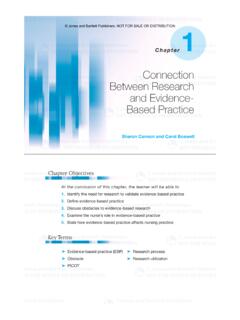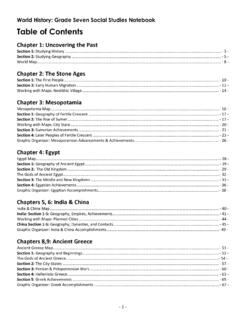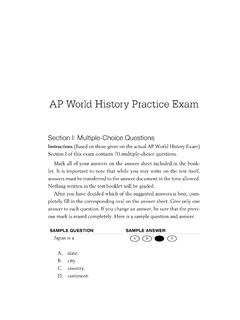Transcription of EARLY HISTORY OF RECREATION AND LEISURE
1 49 CHAPTER 3 EARLY HISTORY OFRECREATION AND LEISURE In the year 80, the Colosseum opened with what must stand as quitethe longest and most disgusting mass binge in Various sorts oflarge-scale slaughter, both of animals and men, were appreciatively watchedby the Emperor Titus and a packed audience for 100 days.. Titus wasquite happy footing the enormous bill just as he and his father, the imperialVespasian, had already footed the bill for building this vast arena. Suchpayments were the privilege of the long run, industrialization brought the reduction of hours per year committed to work have declined in the industrial West in a range from 3,000 3,600 to 1,800 2,000 from 1840 to thepresent.. This redistribution of time has been accompanied by a drastic repackaging of LEISURE hours making possible new forms of LEISURE time,including the typically modern notions of free evenings, the weekend, paidsummer vacations, as well as a lengthy childhood and INTRODUCTIONTo provide a meaningful background for the study of RECREATION and LEISURE in modernsociety, it is helpful to have a clear understanding of its role in the past.
2 We can tracethe origins of many of our contemporary views of LEISURE and related cultural customsto the traditions and practices of ancient cultures. The HISTORY of RECREATION and leisureis a rich tapestry of people, places, events, and social forces, showing the role ofreligion, education, and government and the customs and values of different cultures,their arts, sport, and pastimes. By becoming familiar with the evolution of our recreationand LEISURE , we are better able to understand and deal effectively with the 7/12/07 2:01 PM Page 49 Jones and Bartlett Publishers. NOT FOR SALE OR DISTRIBUTIONTHE PLAY OF EARLY SOCIETIESOne would expect a chronological study to begin by examining the play of prehistoricpeoples during the Paleolithic and Neolithic epochs. However, relatively little isknown about the nature of LEISURE and play in these EARLY periods.
3 Archaeologists haveuncovered artifacts that provide some first-hand evidence of the creative, athletic, andrecreation activities of primitive peoples from around the world. We also haveextrapolated from the accounts of primitive societies written by missionaries andanthropologists in the nineteenth and EARLY twentieth of Games and SportIn primitive societies, play may have had many sources. Popular games were oftenvestiges of warfare, practiced as a form of sport. Musical instruments were likely createdfor use in religious rituals. Pottery, painting, drawings, and other EARLY art provided arecord of both daily life and cultural mythology. Beads and other types of jewelry werecreated as external symbols of individual status and group affiliations. When an activitywas no longer useful in its original form (such as archery for hunting or warfare), itbecame a form of sport offering individuals and groups the opportunity to provephysical skill and strategy.
4 Often, the origin was a religious ritual, in which games wereplayed to symbolize a continuing struggle between good and evil or life and game of tlachtli,widely practiced in Central America centuries ago, is anexample of such a contest. Tlachtli courts were about 200 feet long and 30 feet wideand were situated near temples. A stone ring was fixed about halfway up a wall at eitherend. The players struck a rubber ball with their knees or hips, the purpose being todrive it through one of the hoops. Blank writes:The rubber ball used in the ancient game symbolized the sun, and by making it caromacross the court, players hoped to perpetuate the daily arc of the heavenly ball was no schoolyard shoot-around: Win or lose, the athletes playedfor [I]n pre-Columbian games, members of the losing team were commonlyoffered up for ritual sacrifice, their hearts cut out with blades of razor sharp s one way to shorten the post-game & LEISURE in Modern SocietyTribal people do not make the same sharp distinction between work and LEISURE thatmore technologically advanced societies do.
5 Whereas the latter set aside differentperiods of time for work and relaxation, a tribal, pretechnological society has no suchprecise separations. Instead, work is customarily done when it is available or necessary,and it is often infused with rites and customs that lend it variety and pleasure. In suchtribal societies, work tends to be varied and creative, rather than being a narrow,specialized task demanding a sharply defined skill, as in modern industry. Work is oftenaccompanied by ritual that is regarded as essential to the success of the planting orharvesting or to the building or hunting expedition. The ritual may involve prayer,sacrifice, dance, or feasting, which thus become part of the world of 7/12/07 2:01 PM Page 50 Jones and Bartlett Publishers. NOT FOR SALE OR DISTRIBUTIONCHAPTER 3 EARLY HISTORY of RECREATION and Leisure51 Other Play FunctionsOn the North American continent, play had similar functions among Native Americantribes, helping to equip the young for adult life.
6 Boys practiced warriors skills and weretaught to survive unarmed and unclothed in the wilderness. Girls were taught thehousehold crafts expected of mature women. Through dancing, singing, and storytelling,both sexes learned the HISTORY and religion of their cultures. Among such southwesternNative American tribes as the Navajo, Zuni, or Hopi, shamans or medicine menpracticed healing rites that made use of chanting, storytelling, dancing, sacred kachinadolls, and elaborate, multicolored sand a period ranging from May 1986 to June 1987, archaeologists at the earlyNeolithic site of Jiahu in Henan province, China, uncovered 25 flutes between7,000 and 9,000 years old. Most of the flutes were found at grave sites. Six of theinstruments were intact and are now believed to be the earliest, playable multinoteinstruments.
7 The flutes, which were made of bone, contain seven holes that correspondto a scale similar to the Western eight-note scale. This tone scale indicates thatmusicians living in 7000 could compose and play music. Archaeologists cannot becertain of why so many flutes were located in this part of China. Some believe that theflutes were part of religious rituals; others believe that music was simply a part ofcommunity life. In any case, the discovery of these flutes helps us recognize the veryold tradition of using music as a means of personal expression and cultural flutes dating back from 7000 to 9000 provide insight into the cultural habits of anancient Chinese 7/12/07 2:01 PM Page 51 Jones and Bartlett Publishers. NOT FOR SALE OR DISTRIBUTION52 RECREATION & LEISURE in Modern SocietyRECREATION AND LEISURE IN ancient CIVILIZATIONSAs prehistoric societies advanced, they developed specialization of functions.
8 Humanslearned to domesticate plants and animals, which permitted them to shift from anomadic existence based on hunting and food gathering to a largely stationary way oflife based on grazing animals and planting crops. Ultimately, ruling classes developed,along with soldiers, craftsmen, peasants, and slaves. As villages and cities evolvedand large estates were tilled (often with complex water storage and irrigation systems)and harvested by lower-class workers, upper-class societies gained power, wealth, andleisure. Thus, in the aristocracy of the first civilizations that developed in the MiddleEast during the five millennia before the Christian era, we find for the first time inhistory a LEISURE EgyptThe egyptian culture was a rich and diversified one; it achieved an advancedknowledge of astronomy, architecture, engineering, agriculture , and construction.
9 TheEgyptians had a varied class structure, with a powerful nobility, priesthood, and militaryclass and lesser classes of workers, artisans, peasants, and slaves. This civilization, whichlasted from about 5000 well into the Roman era, was richly recorded in paintings,statuary, and hieroglyphic ancient Egyptians led a colorful and pleasant life; it is said that their energieswere directed to the arts of living and the arts of dying. They engaged in many sport aspart of education and RECREATION , including wrestling, gymnastic exercises, lifting andswinging weights, and ball games. Bullfighting was a popular spectacle and, at least atits inception, was religiously motivated. Music, drama, and dance were forms ofreligious worship as well as social entertainment. The Egyptians had complexorchestras that included various stringed and percussive instruments.
10 Groups of femaleperformers were attached to temples, and the royal houses had troupes of entertainerswho performed on sacred or social Assyria and BabyloniaThe land known as the fertile crescent between two great rivers, the Tigris and theEuphrates, was ruled by two powerful empires, Assyria in the north and Babylon inthe south. These kingdoms were in power for approximately 26 centuries, from about2900 until the invasion by Alexander the Great in 330 Like the ancientEgyptians, the Assyrians and Babylonians had many popular RECREATION activities, suchas boxing, wrestling, archery, and a variety of table addition to watching dancing, listening to music, and giving banquets, Assyrianswere also devoted to hunting; the nobles of Assyria went lion hunting in chariots andon foot, using spears.













